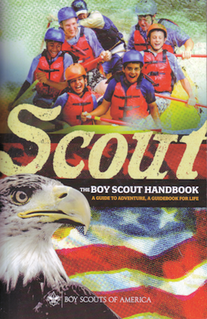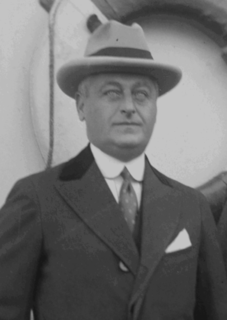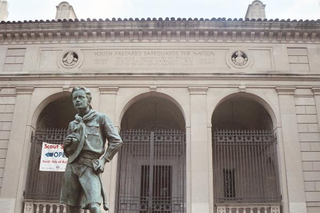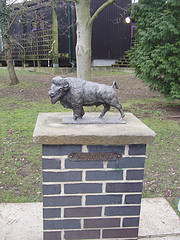
Scouting, also known as the Scout Movement, is a worldwide youth movement employing the Scout method, a program of informal education with an emphasis on practical outdoor activities, including camping, woodcraft, aquatics, hiking, backpacking, and sports. Another widely recognized movement characteristic is the Scout uniform, by intent hiding all differences of social standing in a country and making for equality, with neckerchief and campaign hat or comparable headwear. Distinctive uniform insignia include the fleur-de-lis and the trefoil, as well as merit badges and other patches.

Scouting in Rhode Island has a long history, from the 1910s to the present day, serving thousands of youth in programs that suit the environment in which they live.

Boy Scout Handbook is the official handbook of Scouts BSA. It is a descendant of Baden-Powell's original handbook, Scouting for Boys, which has been the basis for Scout handbooks in many countries, with some variations to the text of the book depending on each country's codes and customs.

Since the publication of Scouting for Boys in 1908, all Scouts and Guides around the world have taken a Scout Promise or oath to live up to ideals of the movement, and subscribed to a Scout Law. The wording of the promise and law have varied slightly over time and among Scouting organizations.

William Hillcourt, known within the Scouting movement as "Green Bar Bill", was an influential leader in the Boy Scouts of America (BSA) organization from 1927 to 1992. Hillcourt was a prolific writer and teacher in the areas of woodcraft, troop and patrol structure, and training; his written works include three editions of the BSA's official Boy Scout Handbook, with over 12.6 million copies printed, other Scouting-related books and numerous magazine articles. Hillcourt developed and promoted the American adaptation of the Wood Badge adult Scout leader training program.

Frederick Russell Burnham DSO was an American scout and world-traveling adventurer. He is known for his service to the British South Africa Company and to the British Army in colonial Africa, and for teaching woodcraft to Robert Baden-Powell in Rhodesia. He helped inspire the founding of the international Scouting Movement.

James Edward West was a lawyer and an advocate of children's rights, who became the first professional Executive Secretary, soon renamed Chief Scout Executive, of the Boy Scouts of America (BSA), serving from 1911 to 1943. Upon his retirement from the BSA, West was given the title of Chief Scout.

Mortimer Loeb Schiff, sometimes Mortimer Leo Schiff, was an American banker and notable early Boy Scouts of America (BSA) leader. His son, John Mortimer Schiff, was also involved with the BSA. He was also the father of Dorothy Schiff, who was the owner and publisher of the New York Post from 1939 to 1976.

The Rhode Island Boy Scouts (RIBS), was an early American Scouting organization that split off from the American Boy Scouts in 1910 and merged with the Boy Scouts of America (BSA) in 1917. RIBS still exists as a trustee organization.

Scouting in the United States is dominated by the 1.2 million-member Boy Scouts of America and the Girl Scouts of the USA and other associations that are recognized by one of the international Scouting organizations. There are also a few smaller, independent groups that are considered to be "Scout-like" or otherwise Scouting related.

The Boy Scouts of America (BSA) was inspired by and modeled on The Boy Scouts Association, established by Robert Baden-Powell in Britain in 1910. In the early 1900s, several youth organizations were active, and many became part of the BSA.
Scouting has sometimes become entangled in social controversies such as in nationalist resistance movements in India. Scouting was introduced to Africa by British officials as an instrument of colonial authority but became a subversive challenge to the legitimacy of British imperialism as Scouting fostered solidarity amongst African Scouts. There are also controversies and challenges within the Scout Movement itself such as current efforts to turn Scouts Canada into a democratic organization.
The Scout and Guide movement in Australia consists of

The 'Unknown Scout' was an anonymous member of The Boy Scout Association in the United Kingdom whose good turn inspired William D. Boyce to form the Boy Scouts of America (BSA).

The Boy Rangers of America was a Scouting program in the United States for boys ages 8 through 12. It was organized on January 24, 1913 in Montclair, New Jersey by Emerson Brooks. Although independent of the Boy Scouts of America, it was the precursor of the BSA's Cubbing program now known as Cub Scouting.

General Edwin Augustus McAlpin was president of the D.H. McAlpin & Co., a tobacco manufacturer. He built the Hotel McAlpin in New York City, at the time the largest hotel in the world. He had an active military career in the New York National Guard and was appointed Adjutant General of New York by the Governor. He was president of the American Boy Scouts and the Mayor of Ossining, New York.
The New England Boy Scouts (NEBS) was an early American Scouting organization that split off from the American Boy Scouts in 1910 and merged with the Boy Scouts of America by 1916.

Elwood Stanley Brown was an American sports organizer in Illinois, Manila, Europe, and South America. In his short life, he made a number of major accomplishments: the intensive promotion of sports among Filipinos, originating international sports competitions in Asia, the promotion of the Olympics around the world, the founding (1910) of the first Boy Scout troops in the Philippines, and initiating and organizing the American Expeditionary Forces games and its corollary the Inter-Allied Games at the end of the War in Europe.
Besides the Boy Scouts of America (BSA) and Girl Scouts USA, both of which still exist, there were other Scouting and Scout-like organizations that arose over the years in the United States. Many are now defunct, including these examples.
















